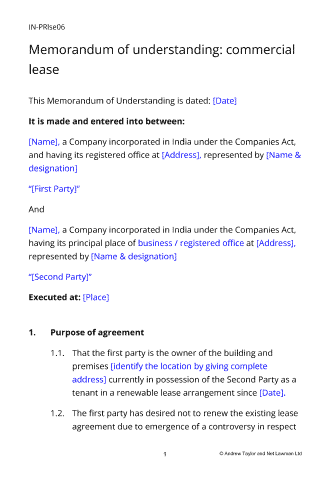Memorandum of understanding

Document overview


- Length:5 pages (1204 words)
- Available in:
 Microsoft Word DOCX
Microsoft Word DOCX Apple Pages
Apple Pages RTF
RTF

If the document isn’t right for your circumstances for any reason, just tell us and we’ll refund you in full immediately.

We avoid legal terminology unless necessary. Plain English makes our documents easy to understand, easy to edit and more likely to be accepted.

You don’t need legal knowledge to use our documents. We explain what to edit and how in the guidance notes included at the end of the document.

Email us with questions about editing your document. Use our Lawyer Assist service if you’d like our legal team to check your document will do as you intend.

Our documents comply with the latest relevant law. Our lawyers regularly review how new law affects each document in our library.
About this document
The execution of this document creates a Memorandum of Understanding between two companies one of whom is the landlord/owner of the premises occupied by the other as a tenant to run a business. The landlord has determined the lease and the tenant company are being offered compensation for vacating the premises.
The format is fit to be used to address peculiar situations where mostly commercial properties are sought to be vacated on determination of lease and precisely where the tenant intended to continue with a renewal of the lease period.
There are no specific legal provisions that govern a legal document of this nature; you still have the liberty to make alterations and additions that exactly suit your situation or the case. With very small changes the document can be altered to use in completely different circumstances such as for residential properties.
Who will use this document?
Any Company, business or individual – holding clear title, finalizing full and final settlement terms with a tenant for peaceful vacation of a rented commercial premises.
Application and features
- Very flexible to suit the requirements of either or both parties;
- Provides a complete framework;
- Protects both sides;
- Objective settlement to avoid unnecessary litigation;
- Saving of money for both parties.
Contents
- Appropriate legal provisions - warranties, exclusions, indemnities, etc.
- Objects of agreement clearly defined;
- Dispute resolution;
- Reasonableness;
- Time schedule for payment;
- Successors and assigns;
- Jurisdiction;
- Practical terms that protect parties from future disputes.

Choose the level of support you need
Document Only
This document
Detailed guidance notes explaining how to edit each paragraph
Lawyer Assist
This document
Detailed guidance notes explaining how to edit each paragraph
Unlimited email support - ask our legal team any question related to completing the document
- Review of your edited document by our legal team including:
- reporting on whether your changes comply with the law
- answering your questions about how to word a new clause or achieve an outcome
- checking that your use of defined terms is correct and consistent
- correcting spelling mistakes
- reformatting the document ready to sign
Bespoke
A document drawn just for you to your exact requirements
Personalised service provided by an experienced solicitor
Free discussion before we provide an estimate, for you to ask questions and for us to understand your requirements
Transparent fees - a fixed fee for the basic work, a fixed hourly rate for new or changed instructions, and no charge for office overheads or third party disbursements
Careful and thorough consideration of your circumstances and your consequent likely practical and legal requirements
Provision of options that you may not have considered with availability for discussion
Help and advice woven into the fabric of our service so that you can make the best decisions
All rights reserved
